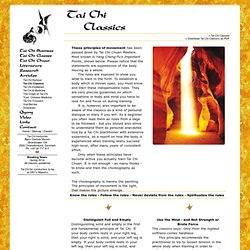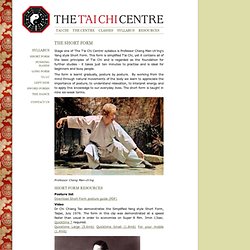

Qigong.pdf. Tai chi Classics. Tai Chi Classics. These principles of movement has been passed down by Tai Chi Chuan Masters.

Most known is Yang Cheng-Fu's Important Points, shown below. Please notice that the statements are expressions of the body moving as a whole. The rules are exposed to show you what to train in the form. To establish a body which is thrown open, you must know and train these indispensable rules. They are very precise guidelines on which sensations in body and mind you have to look for and focus on during training.
It is, however, also important to be aware of the classics as a kind of personal dialogue or diary if you will. Only when these principles have become active you actually train Tai Chi Chuan. The choreography is merely the painting. Know the rules - Follow the rules - Never deviate from the rules - Spiritualize the rules Distinguish Full and Empty Distinguishing solid and empty is the first and fundamental principle of Tai Chi. The Energy at the top of the Headshould be light and sensitive. Tai chi Classics. Cheng Man-Ch'ing Taijiquan - Short Form - Grandmaster Lin Feng-Chao.
WORLD's GREATEST TAI CHI MASTER.
Variations on Cheng Man Ching 37 Posture Short Form · Tai Chi, Qigong, Yoga, Fitness in Portland, Oregon PDX · David Vanadia. Cheng Man-ch'ing. Cheng Man-ch'ing or Zheng Manqing (29 July 1902 - 26 March 1975) was born in Yongjia (present-day Wenzhou), Zhejiang Province (his birthday was on the 28th year of the Guangxu emperor's reign, 6th month, 25th day, which corresponds to July 29, 1902).[1] He died March 26, 1975; his grave is near the city of Taipei.

Cheng was trained in Chinese medicine, t'ai chi ch'uan, and the three perfections: calligraphy, painting and poetry. Because of his skills in these five areas (among some of the traditional skills and pastimes of a Confucian scholar in traditional China) he was often referred to as the "Master of Five Excellences. " Because he had been a college professor, his students called him "Professor Cheng. " Early years[edit] Cheng's father died when Cheng was very young. Cheng taught poetry and art in several leading colleges in Beijing and Shanghai and was a successful artist. In addition to his childhood instruction, Cheng Man-ch'ing received formal Chinese medical training. Note: Great River T'ai Chi Ch'uan / Taijiquan. Cheng Man Ching 37 Posture Tai Chi Yang Short Form (1) The Tai Chi Centre - Syllabus: Short Form. Stage one of 'The T'ai Chi Centre' syllabus is Professor Cheng Man-ch'ing's Yang style Short Form.

This form is simplified T'ai Chi, yet it contains all of the basic principles of T'ai Chi and is regarded as the foundation for further studies - it takes just ten minutes to practise and is ideal for beginners and busy people. The form is learnt gradually, posture by posture. By working from the mind through natural movements of the body we learn to appreciate the importance of posture, to understand relaxation, to interpret energy and to apply this knowledge to our everyday lives.
What is Tai Chi? The Chinese characters for Tai Chi Chuan can be translated as the 'Supreme Ultimate Force'.

The notion of 'supreme ultimate' is often associated with the Chinese concept of yin-yang, the notion that one can see a dynamic duality (male/female, active/passive, dark/light, forceful/yielding, etc.) in all things. 'Force' (or, more literally, 'fist') can be thought of here as the means or way of achieving this ying-yang, or 'supreme-ultimate' discipline. Tai Chi, as it is practiced in the west today, can perhaps best be thought of as a moving form of yoga and meditation combined. There are a number of so- called forms (sometimes also called 'sets') which consist of a sequence of movements. Many of these movements are originally derived from the martial arts (and perhaps even more ancestrally than that, from the natural movements of animals and birds) although the way they are performed in Tai Chi is slowly, softly and gracefully with smooth and even transitions between them.